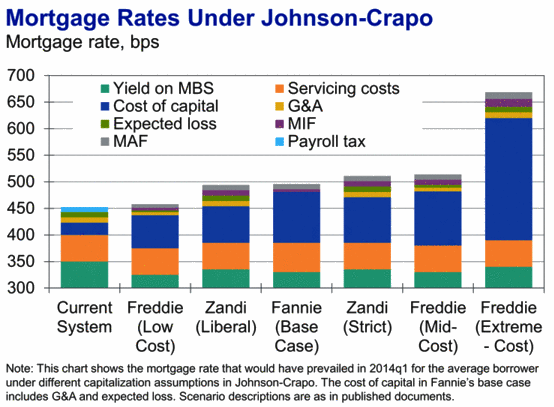Everyone seems to agree that Fannie Mae and Freddie Mac need to go away. Well, maybe not the hedge funds that hold their stock.
Nevertheless, there are still plenty of concerns regarding their possible exit, one being the impact to mortgage rates.
While still historically low, everyone agrees that interest rates would rise if the pair were to be replaced by a new housing finance system, something that could become a reality if the Johnson-Crapo housing reform bill eventually becomes law.
This week, the bipartisan legislation will be discussed in front of the Senate Banking Committee, and opponents could point to unaffordable rates as a reason to shoot down the bill.
Interest Rates Could Be 2% Higher?

Last week, Fannie Mae and Freddie Mac released cost estimates if the legislation were to be enacted.
They included low-cost, mid-cost, and extreme-cost estimates. Under the low-cost scenarios, interest rates would barely budge.
But if Freddie’s extreme-cost scenario were realized, mortgage rates would rise more than 2%, enough to really turn housing affordability on its head.
Of course, there’s a reason it’s referred to as “extreme.” It probably won’t go down that way, though legislators do need to get the details right to avoid any uncertainty.
Moody’s Analytics co-founder Mark Zandi weighed in on the subject, arguing that interest rates probably won’t rise all that much as long as capital requirements are ironed out beforehand.
Long story short, raising the required level of capital will lead to higher interest rates, and how those capital requirements are implemented is key.
How About a Half Point Instead?
While that’s still unclear, Zandi and his colleague Cristian deRitis made some assumptions about the cost of various forms of capital and found that rates probably wouldn’t climb much higher.
In fact, they believe the Johnson-Crapo legislation would likely only cause mortgage rates to rise anywhere from 41 (liberal case) to 58 (strict case) basis points.
So instead of enjoying a 4.5% rate on your 30-year fixed mortgage, you’d be subjected to a rate of about 5% or 5.125% instead.
On a $200,000 mortgage, you’d have to pay another $60 or so each month, which probably wouldn’t make or break most borrowers.
Yes, it’s still meaningful, but the current housing finance system puts taxpayers at risk, which clearly isn’t favorable either.
For the record, Fannie and Freddie’s mid-cost estimates are pretty similar to what Zandi came up with, so the consensus is that rates wouldn’t rise all that much.
As you can see from the chart above, most scenarios aren’t that apocalyptic, so we probably don’t have too much to worry about on the interest rate front.
Additionally, Zandi noted that any increase would be phased in over as long as a decade, surely enough time for the market to adjust if need be.
Still, this is all very convenient to consider when mortgage rates remain in unprecedented territory.
Assuming they eventually rise back to more normal levels, this legislation could make housing increasingly expensive and force more borrowers to stay in their homes longer than they normally would.

